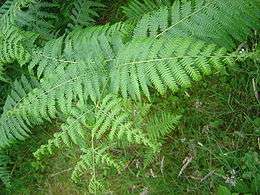Haumia-tiketike

In Māori mythology, Haumia-tiketike (or simply Haumia) is the god of wild or uncultivated foods. Haumia was a son of Rangi and Papa, and agreed to the forced separation of his parents. Because of this he was subjected to the fury of his brother Tāwhirimātea, god of winds and storms, who would have killed him if their mother had not hidden him in her body, that is, in the ground. While he escaped from Tāwhirimātea, he was later discovered by Tū, god of war (here representing humankind), who saw Haumia's hair sticking up out of the earth. Haumia contrasts with his brother Rongo, the god of the kūmara and all cultivated plants (Grey 1956:7-10, Orbell 1998:29, Tregear 1891:54).
Haumia is particularly associated with fernroot or aruhe, the starchy rhizome of the bracken fern Pteridium esculentum, which became a major element of the Māori diet in former times. Food-quality rhizomes were only obtained from bracken growing in deep, moderately fertile soils. Bracken became abundant after the arrival of Māori, "mainly a result of burning to create open landscapes for access and ease of travel" (McGlone et al., 2005:1). Aruhe was dug in early summer and dried for use in the winter. Although it was not liked as much as kūmara, it was appreciated for its ready availability and the ease with which it could be stored (Orbell 1998:29).
Genealogy
- In the Arawa version (given above), Haumia is a son of Rangi and Papa. However, in the southern Bay of Plenty and parts of the East Coast, Haumia is a son of Tāne and grandson of Rangi and Papa (Orbell 1998:29).
- White mentions a legend in which Haumia is the son of Tama-nui-a-raki, who is the son of Raki and Hekeheke-i-papa (White 1887-1891, I:20). The 'k' in Raki reveals that this is a South Island version, as 'Raki' is 'Rangi' in the North Island.
Names and epithets
- Haumia-tiketike
- Haumia
References
- G. Grey, Polynesian Mythology, Illustrated edition, reprinted 1976. (Whitcombe and Tombs: Christchurch), 1956.
- M. S. McGlone, J. M. Wilmshurst, and Helen M. Leach, 'An ecological and historical review of bracken (Pteridium esculentum) in New Zealand, and its cultural significance' New Zealand Journal of Ecology (2005) 29(2): 165–184.
- M. Orbell, The Concise Encyclopedia of Māori Myth and Legend (Canterbury University Press: Christchurch), 1998.
- E. R. Tregear, Maori-Polynesian Comparative Dictionary (Lyon and Blair: Lambton Quay), 1891.
- J. White, The Ancient History of the Maori, 6 Volumes (Government Printer: Wellington), 1887-1891.